Have you ever reached a plateau with your content? You come to a point where you have a predictable amount...
The post How to Beat the Boring Content Blues in 30 Days appeared first on Copyblogger.
from Copyblogger https://ift.tt/32UuyJ8
via IFTTT
Have you ever reached a plateau with your content? You come to a point where you have a predictable amount...
The post How to Beat the Boring Content Blues in 30 Days appeared first on Copyblogger.
When it comes to your B2B marketing strategy, your tactical approach to mobile should be different than that of your offline and online strategies. And, it’s not just about the screen size or functionality.
There are other aspects to both your email campaigns and website that you’ll need to tweak in order to create a more effective user experience (UX) for your customers and prospects as part of your mobile marketing strategy.
Mobile Email Campaign ChangesWhen it comes to planning mobile email campaigns, here are some things to differently knowing you have a different screen size and platform:
The tweaks you need to do when it comes to viewing your website on a mobile device involve essentially creating an entirely different website that works for mobile devices, including screen size, functionality, touchscreen capability, and load time. A mobile-responsive website design will automatically recognize and adjust to the device it’s viewed on, which delivers great value in terms of time and money ROI. Similar tweaks like those suggested for mobile emails related to visuals, minimal content, and easy functionality and interaction also apply to your mobile website strategy.
Other tweaks to make to your mobile website include:
From tablets to various smartphone products, it’s important to test all your mobile marketing interactions to ensure they work well and deliver that frictionless user experience that keeps users engaged with your mobile presence. Beyond testing internally, find external users willing to test and provide feedback so you can continue tweaking until you optimize your mobile results for your business.
Consumers check their mobile devices 150 times a day at least. Do you have a mobile strategy in place? Find out what you need to “Go Further with Mobile Marketing.”
Your precious words. You know they’ve got to be right to attract the audience you want. You’ve carefully crafted each...
The post 8 Incredibly Simple Ways to Get More People to Read Your Content appeared first on Copyblogger.
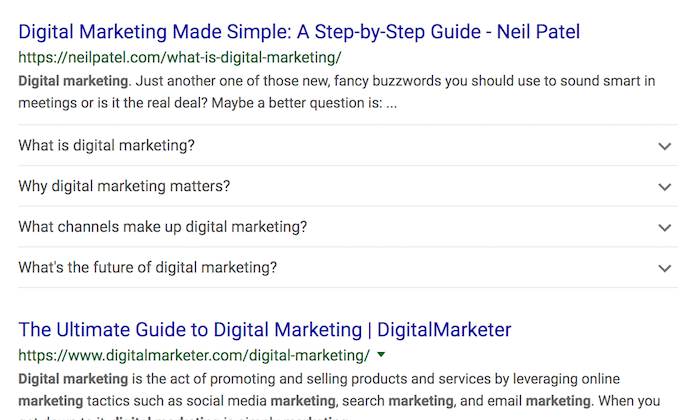
I’ve been testing a new SEO hack and it works no matter how old or how new your site is.
Heck, you can have barely any links, and I’ve found it to work as well.
Best of all, unlike most SEO changes, it doesn’t take months or years to see results from this… you can literally see results in less than 30 minutes.
And here’s what’s crazy: I had my team crawl 10,000 sites to see how many people are leveraging this SEO technique and it was only 17.
In other words, your competition doesn’t know about this yet!
So what is this hack that I speak of?
Not only is Google changing its algorithm on a regular basis, but they also test out new design elements.
For example, if you search for “food near me”, you’ll not only see a list of restaurants but you also see their ratings.
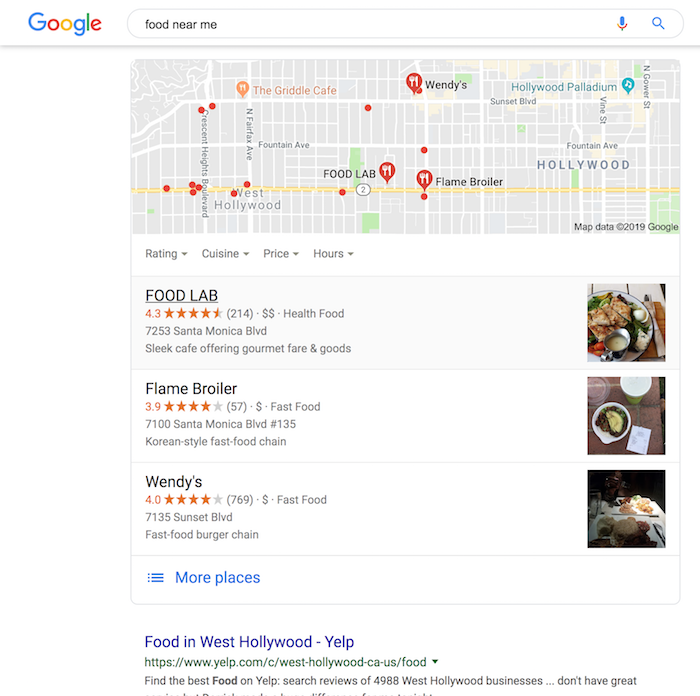
And if you look up a person, Google may show you a picture of that person and a quick overview.
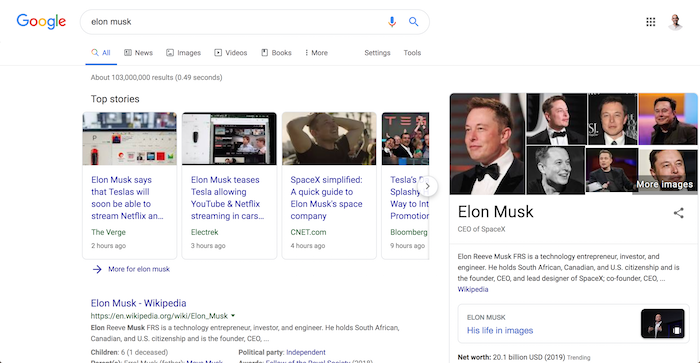
Over the years, Google has adapted its search results to give you the best experience. For example, if you search “2+2” Google will show you the answer of “4” so you don’t have to click through and head over to a webpage.

But you already know this.
Now, what’s new that no one is really using are FAQ-rich results and Answer Cards.
Here’s what I mean… if you search “digital marketing” you’ll see that I rank on Google. But my listing doesn’t look like most people’s…
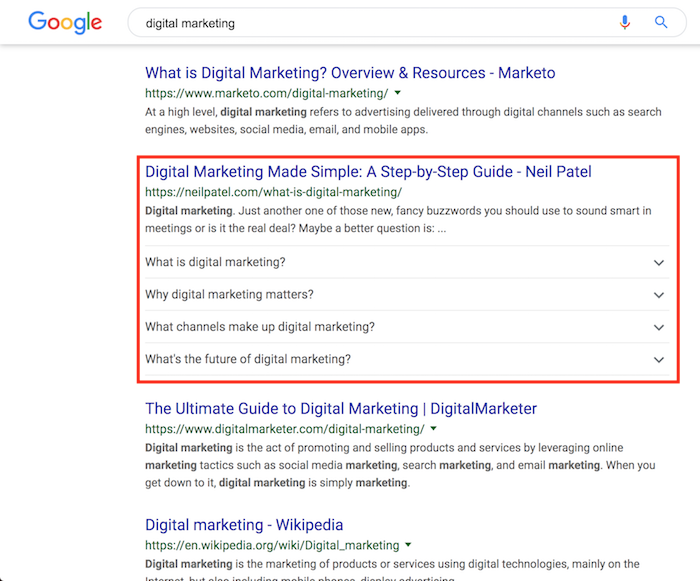
As you can see from the image above, Google has pulled FAQ rich results from my site.
And best of all, I was able to pull it off in less than 30 minutes. That’s how quickly Google picked it up and adjusted their SERP listing.
Literally all within 30 minutes.
And you can do the same thing through Answer Cards anytime you have pages related to question and answers.
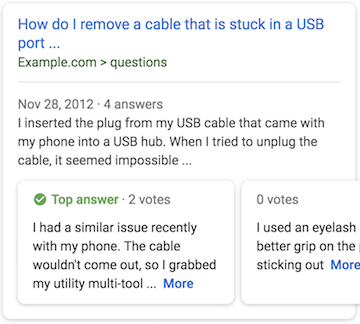
So how can you do this?
Before we get this going with your site, you have to pick the right schema markup.
FAQpage schema is used when you offer a Frequently Asked Question page or have a product page that contains frequently asked questions about the product itself. This will let you be eligible for a collapsible menu under your SERP with the question, that when clicked on, reveals the answer.
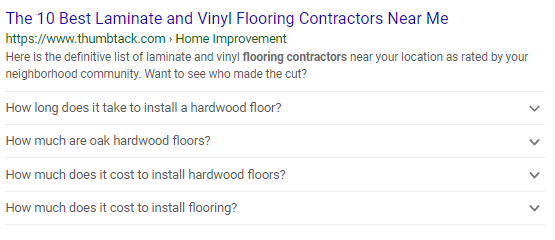
It can also let you be eligible for FAQ Action that is shown on Google Assistant. This can potentially help get you noticed by people using voice search to find out an answer!
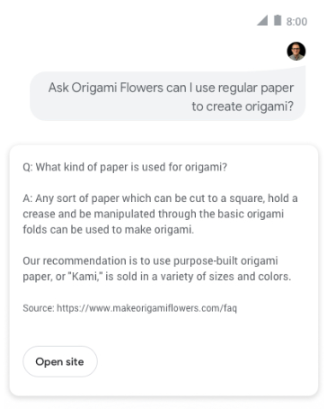
Q&A schema is used when people are contributing different types of answers and can vote for which answer they think is the best. This will provide the rich result cads under your SERP and shows all the answers, with the top answer highlighted.
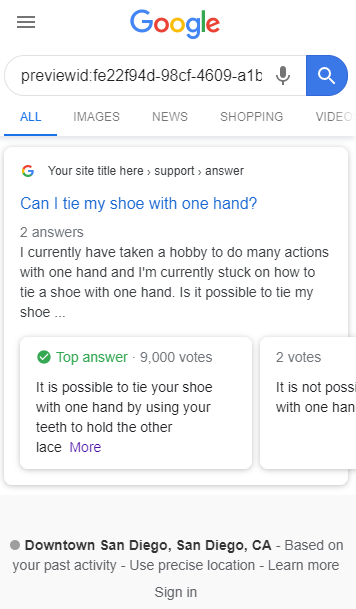
After making sure you understand what these are used for, Google also has additional guidelines on when you can and can’t use these schema’s for:
Google has a list of FAQpage schema guidelines.
Only use FAQPage if your page has a list of questions with answers. If your page has a single question and users can submit alternative answers, use QAPage instead. Here are some examples:
Valid use cases:
Invalid use cases:
And here are the guidelines for Q&A schema:
Only use the QAPage markup if your page has information in a question and answer format, which is one question followed by its answers.
Users must be able to submit answers to the question. Don’t use QAPage markup for content that has only one answer for a given question with no way for users to add alternative answers; instead, use FAQPage. Here are some examples:
Valid use cases:
Invalid use cases:
If your content meets these guidelines, the next step is to figure out how to implement the schema onto your website and which type to use.
There are two ways to implement it… either through JSON-LD or Microdata.
I recommend choosing one style and sticking to it throughout your webpage, and I also recommend not using both types on the same page.
JSON-LD is what Google recommends wherever possible and Google has been in the process of adding support for markup-powered features. JSON-LD can be implemented into the header of your content and can take very little time to implement.
The other option is Microdata, which involves coding elements into your website. This can be a challenging process for some odd reason, I prefer it. Below are examples of how each work.
<html>
<head>
<title>Digital Marketing Frequently Asked Questions (FAQ) – Neil Patel</title>
</head>
<body>
<script type=”application/ld+json”>
{
“@context”: “https://ift.tt/2NfgAO9;,
“@type”: “FAQPage”,
“mainEntity”: [
{
“@type”: “Question”,
“name”: “What is digital marketing?”,
“acceptedAnswer”: {
“@type”: “Answer”,
“text”:”Digital marketing is any form of marketing products or services that involves electronic device”}
}]
}
</script>
</body>
</html>
<html itemscope itemtype=”https://ift.tt/2YqfNdK;>
<head>
<title>Digital Marketing Frequently Asked Questions (FAQ) – Neil Patel</title>
</head>
<body>
<div itemscope itemprop=”mainEntity” itemtype=”https://ift.tt/2K38SmB;>
<h3 itemprop=”name”>What is digital marketing?</h3>
<div itemscope itemprop=”acceptedAnswer” itemtype=”https://ift.tt/2YrIirz;>
<div itemprop=”text”>
<p>Digital marketing is any form of marketing products or services that involves electronic device.</p>
</div>
</div>
</div>
</body>
</html>
{
“@context”: “https://ift.tt/2NfgAO9;,
“@type”: “QAPage”,
“mainEntity”: {
“@type”: “Question”,
“name”: “Can I tie my shoe with one hand?”,
“text”: “I currently have taken a hobby to do many actions with one hand and I’m currently stuck on how to tie a shoe with one hand. Is it possible to tie my shoe with one hand?”,
“answerCount”: 2,
“upvoteCount”: 20,
“dateCreated”: “2019-07-23T21:11Z”,
“author”: {
“@type”: “Person”,
“name”: “Expert at Shoes”
},
“acceptedAnswer”: {
“@type”: “Answer”,
“text”: “It is possible to tie your shoe with one hand by using your teeth to hold the other lace”,
“dateCreated”: “2019-11-02T21:11Z”,
“upvoteCount”: 9000,
“url”: “https://example.com/question1#acceptedAnswer”,
“author”: {
“@type”: “Person”,
“name”: “AnotherShoeMan”
}
},
“suggestedAnswer”: [
{
“@type”: “Answer”,
“text”: “It is not possible to tie your shoe with one hand”,
“dateCreated”: “2019-11-02T21:11Z”,
“upvoteCount”: 2,
“url”: “https://example.com/question1#suggestedAnswer1”,
“author”: {
“@type”: “Person”,
“name”: “Best Shoe Man”
}
}
]
}
}
<div itemprop=”mainEntity” itemscope itemtype=”https://ift.tt/2K38SmB;>
<h2 itemprop=”name”>Can I tie my shoe with one hand?</h2>
<div itemprop=”upvoteCount”>20</div>
<div itemprop=”text”>I currently have taken a hobby to do many actions with one hand and I’m currently stuck on how to tie a shoe with one hand. Is it possible to tie my shoe with one hand?</div>
<div>asked <time itemprop=”dateCreated” datetime=”2019-07-23T21:11Z”>July 23’19 at 21:11</time></div>
<div itemprop=”author” itemscope itemtype=”https://ift.tt/2K75yY1
itemprop=”name”>Expert at Shoes</span></div>
<div>
<div><span itemprop=”answerCount”>2</span> answers</div>
<div><span itemprop=”upvoteCount”>20</span> votes</div>
<div itemprop=”acceptedAnswer” itemscope itemtype=”https://ift.tt/2YrIirz;>
<div itemprop=”upvoteCount”>9000</div>
<div itemprop=”text”>
It is possible to tie your shoe with one hand by using your teeth to hold the other lace.
</div>
<a itemprop=”url” href=”https://example.com/question1#acceptedAnswer”>Answer Link</a>
<div>answered <time itemprop=”dateCreated” datetime=”2019-11-02T22:01Z”>Nov 2 ’19 at 22:01</time></div>
<div itemprop=”author” itemscope itemtype=”https://ift.tt/2K75yY1 itemprop=”name”>AnotherShoeMan</span></div>
</div>
<div itemprop=”suggestedAnswer” itemscope itemtype=”https://ift.tt/2YrIirz;>
<div itemprop=”upvoteCount”>2</div>
<div itemprop=”text”>
It is not possible to tie your shoe with one hand
</div>
<a itemprop=”url” href=”https://example.com/question1#suggestedAnswer1″>Answer Link</a>
<div>answered <time itemprop=”dateCreated”datetime=”2019-11-02T21:11Z”>Nov 2 ’19 at 21:11</time></div>
<div itemprop=”author” itemscope itemtype=”https://ift.tt/2K75yY1
itemprop=”name”>Best Shoe Man</span></div>
</div>
</div>
</div>
When you are implementing it on your website, feel free and just use the templates above and modify them with your content.
If you are unsure if your code is correctly implemented or not, use Google’s Structured Data Testing Tool and you can add your code snippet or the page that you implemented the schema on and it will tell you if you did it right or wrong.
Plus it will give you feedback on if there are any errors or issues with your code.
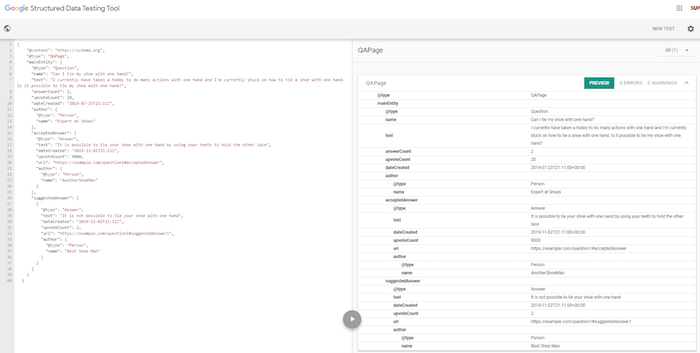
You can also try Google’s Rich Result Tester. This will give you a brief look at how your structured data will look like in the results!
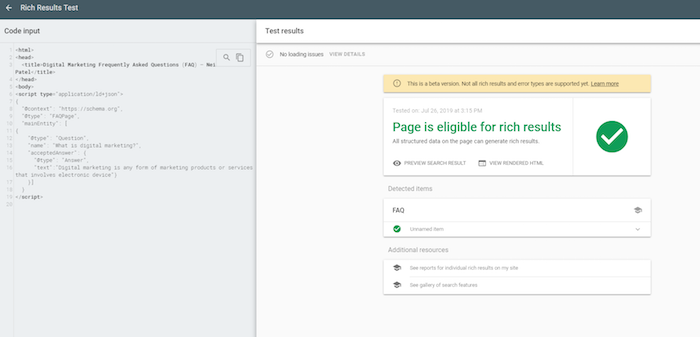
Once you make the changes to any page that you think is a good fit, you’ll want to log into Google Search Console and enter the URL of the page you modified in the top search bar.
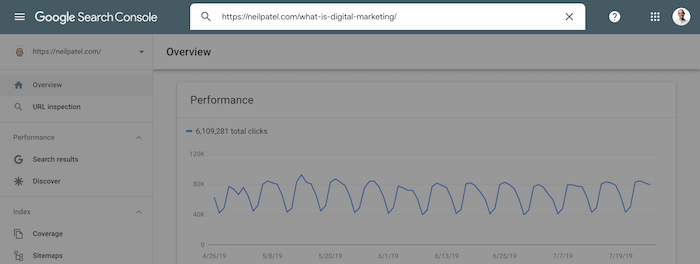
You’ll then want to have Google crawl that page so they can index the results. All you have to do is click “request indexing”.
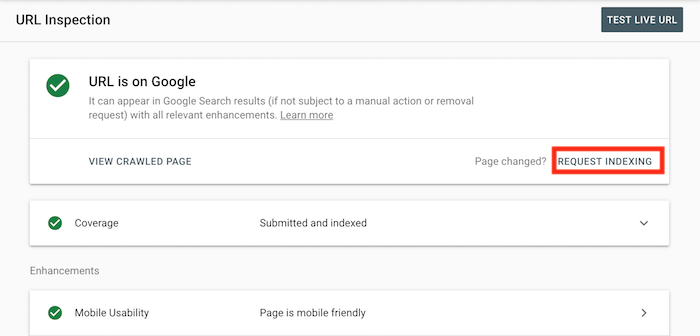
And typically within 10 minutes, you’ll notice it kick in and when you perform a Google search you’ll see your updated listing.
Now the key to making this work is to do this with pages and terms that already rank on page 1. That’s where I’ve seen the biggest improvement.
Will this help with People Also Ask and Featured Snippets? So far, there has been no correlation between schema markup and People Also Ask or Featured Snippets and you do not need them to be featured in them.
Optimizing your content for this will not hurt you though and can potentially improve your chances to be on here.
Google has been testing out how they can show these types of Q&A, FAQ, and How-To results and looking at structured data to help understand them.
It’s better to be early to the game and help Google understand your pages, as well as possibly participating in any of Google’s experiments.
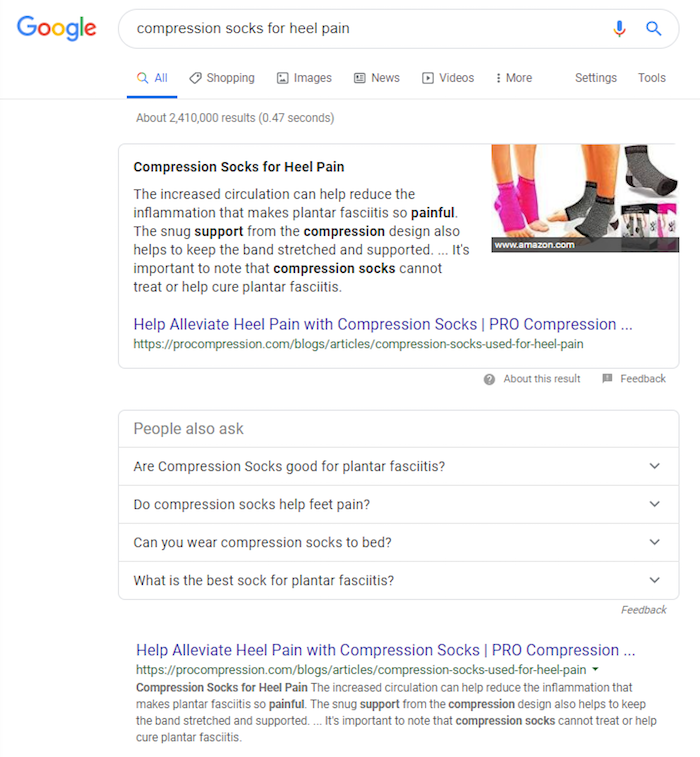
With more and more people using mobile devices to find answers to questions, this is a very relevant question!
Especially considering that over half of the searches on Google will be from voice search in the near future.
Answers from voice search get most of their answers from featured snippets.
And adding structured data on your website increases the chances of getting you into featured snippets, which increases the chance of you getting featured on voice search.
This simple hack can potentially increase the visibility of your brand and help improve the authority of your website. It’s a simple solution that can take a single day to implement across your main question, product, or FAQ page.
I’ve been using it heavily for the last week or so and as long as I pick keywords that I already rank on page 1 for, I am seeing great results.
And as I mentioned above, when my team analyzed 10,000 sites we only found 17 to be using FAQ and QA schema. In other words, less than 1% of the sites are using this, which means you if you take advantage now, you’ll have the leg up on your competition.
So what do you think about this tactic? Are you going to use it?
The post Advanced Hack: How to Improve Your SEO in Less Than 30 Minutes appeared first on Neil Patel.
VerticalResponse is always working to improve the user experience, and we’re excited to announce a series of updates to our email marketing tools that make it faster and easier than ever to connect with your audience, build compelling campaigns and track results. Here’s a rundown of our newest features.
Some of our users take advantage of monthly subscriptions to send unlimited emails. Others purchase credits because they send emails less frequently. If you’re in the latter camp, this update is for you. Now, you can choose the exact number of credits you need instead of paying for a predefined block.
For example, you no longer need to pay for a block of 2,500 credits if you only need 2,347 credits. Simply enter the exact number you need and checkout. Our new pay as you go feature makes it easy to control email marketing costs and maximize your return on investment.

Now you can customize campaign download reports with custom fields. Choose exactly what you want to include in your report, including any custom fields you create for your contact list. Examples include birthdays, customer IDs, question responses and any other data you want to collect.
To access this feature, click on the message name and then “download report.” Then, choose the custom fields to include from the dropdown located near the bottom of the Download Report page.

Do you use Google Analytics? If so, now you can use it to track email campaign performance. See which email links your subscribers click, and track their journey through your website. It’s a great way to bring your analytics all under the same roof.
To add Google Analytics tracking to your emails, check the box at the bottom of the page where you designate which contacts will receive your email.

Add a personalized touch to your sign-up form opt-in confirmation emails. Now you can create a custom confirmation message for each sign-up form. You can also customize the from name, address, subject line and confirmation button text — plus direct subscribers to a custom landing page URL after they click the confirm button.
Custom confirmation emails can be tailored to your audience to help increase opt-in conversions, and custom landing pages can encourage new subscribers to act. Use them to introduce subscribers to your products, services, a special offer or anything else you’d like.
These new customization options are available in Step 3 of the sign-up form creator.

Want to make a list of contacts added before or after a given date, or during a defined date range? Now you can with our new “date added” search filter. This is a useful tool if you want to create a new campaign that targets subscribers based on when they were added to your list. You can even use this feature to filter other contact search results, allowing you to fine-tune your mailing lists for advanced targeting.


We’ve renamed our email report tabs for clearer, easier-to-understand metrics. The new tabs reflect common industry nomenclature such as “Sent,” “Opens” and “Clicks” for simpler reporting on the metrics that matter.

Now you can check your email campaign stats on the go with our new mobile functionality. It offers real-time campaign statistics on your smartphone, lets you verify that scheduled emails were sent and allows you to view past and upcoming emails.
Mobile functionality makes it easy to stay on top of your email campaign performance from anywhere. It’s a value-added service that works on any mobile device with a web browser.

(Currently, mobile functionality is not available to VerticalResponse Classic or Deluxe Marketing Suite users.)
Our email builder updates make it easier than ever to craft compelling email layouts. Previously, clicking on content blocks would move them to the bottom, then you would need to move them up to the position you wanted. Now, you can drag content blocks directly into the builder and place them wherever you want.
The update turns a two-step process into an intuitive one-step process, making our email builder more user-friendly than ever.

VerticalResponse is dedicated to consistently improving the user experience so you can craft compelling email campaigns that get opened, get clicked and help you earn more sales. Stay tuned for future updates!
© 2019, Brian Morris. All rights reserved.
The post Enjoy a better user experience with our latest updates appeared first on VerticalResponse Blog.
Nothing can destroy your email marketing performance quite like email deliverability problems. Whether it’s the slow slip of inbox placement due to diminishing engagement or the sudden collapse due to a block or blacklisting, it’s always devastating and usually a shock.
But, honestly, email deliverability problems are rarely a surprise if you know what to look out for. During my nearly 10 years focused on deliverability, I’ve noticed a number of events that often precede email deliverability problems:
1. Changing Email Service ProvidersThis is perhaps the biggest change you can make to your email program. Changing providers is essentially starting from scratch—you have new IP addresses and a new sending subdomain, neither of which have a reputation associated with them. You also need to worry about things like importing the suppression list from your old provider, so that you don’t start off on the wrong foot by mailing to a bunch of bad addresses.
It’s wise to have a deliverability consultant monitoring your inbox placement closely during the ramp up phase, which generally takes 4-6 weeks. Speaking of the warming up process...
2. Warming Up a New IP AddressIf you change the IP address that you send emails from or add a new one, you can’t just start sending tons of emails from the new IP address on day 1. That’s what spammers do, as they jump around from one IP address to another to try to avoid detection. This behavior will get your emails blocked.
Instead, you need to gradually ramp up email volume from a new IP address in a methodical way to give mailbox providers a chance to see that their users are responding positively to it. There’s an ever-changing formula for warming up an IP address properly, and it takes a watchful eye to know when to dial volume back to give the process more time.
3. Warming Up a New Sending SubdomainYour sending subdomain (i.e., email.brand.com) is just as important as your IP address. Mailbox providers watch both of these closely, which is why you can’t simply change your IP address to run away from a poor sender reputation. Even if you change your sending subdomain, that poor reputation can be tied back to your main domain, which no legitimate business can abandon.
Brands should be even more careful when warming up a new sending subdomain, because the sender reputation associated with it is even stickier than the one associated with your IP address.
4. When Doing High-Volume Ad-Hoc SendsPrivacy policy update, anyone? Once-a-year or one-time emails like this that are sent to your full list—often even disengaged and chronically inactive subscribers, and sometimes even those who unsubscribed or complained—can sometimes lead to deliverability issues. Brands should plan for such a large send by considering the regular daily volume for their domain and IPs, and the incremental increase beyond that average send volume. If that volume jump will more than double your daily send volume, it can cause a red flag for mailbox providers who will, in turn, block your mail. It’s also important to watch deliverability closely after sending an email like this, in order to quickly address any delivery issues that crop up as a result.
5. During Peak Season SendingWith so much business riding on your performance during your peak seasons, it’s the worst time to have email deliverability problems. But your peak seasons are also the peak seasons for your competitors and peers, which often means a spike in emails at mailbox providers, putting them on their guard.
If you’ve experienced deliverability issues in the past during your highest volume seasons, then your risk of problems in the future is even higher. It’s important for senders to prepare in advance for an increase in volume during peak season. We help our clients employ strategies like ramping up in advance and running a reactivation program to bring more people back into their active file long before the pressure is on to send more.
6. When Bounce Rates Start to Exceed 3%-5%There are two types of bounces to be concerned about:
Hard bounces, which are invalid addresses, either because the address has never been active or because the address was abandoned and then retired by the mailbox provider
Soft bounces, which are temporary blocks by mailbox providers that can be related to things like reputation or volume
The most common reason that emails hard bounce is that the email address you’re trying to send email to doesn’t exist. Spammers often have high bounce rates, because their lists generally have lots of expired and guessed email addresses, since they try to reach the largest audience possible. So, when you send to a lot of bad addresses and your hard bounce rate is high, mailbox providers take this as a sign that you might be a spammer—or at least that you’re being reckless with your subscriber acquisition processes. If your hard bounce rates ever rise above 5% in any given month, it’s a good idea to seek professional help to find the source of the problem that’s causing so many invalid email addresses to get onto your list.
For any large sender, some amount of soft bouncing is normal due to deferrals from smaller mailbox providers that can only accept so much mail at a certain time. However, if you see a soft bounce rate upwards of 3%, especially at the top providers like Gmail and Outlook.com, then you may be getting blocked due to reputation issues. A deliverability consultant can help you identify the root cause, make a plan for improvement, and (in some cases) get the block removed on your behalf.
7. When Opening Up a New Subscriber Acquisition SourceEach of your subscriber acquisition sources has a different value-risk mix because they attract subscribers who have different goals, different levels of familiarity with your brand, different expectations, and so on.
For instance, people who opt in during checkout are familiar with your brand and have made at least one purchase. The chances of their email address bouncing are lower, because they want their email receipt, and the likelihood of them being disappointed with your email content is low because they’ve already shown an affinity for your brand by making a purchase and raising their hand to receive your emails.
At the other end of the spectrum are people who are getting onto your email list through, for instance, a sweepstakes or co-registration. People who opt in via a sweepstakes may only be interested in winning a prize and not interested in receiving your emails. And people who opt in via a co-registration form may not be familiar with your brand or may be confusing it with another brand. In either case, these subscribers are a high risk of spam complaints and unsubscribes.
Because of the different value-risk mix of every subscriber acquisition source, you should watch your deliverability closely when adding a new one.
8. During Periods of Faster-than-Usual List GrowthTrack your list size and understand what your baseline list growth is so you can identify any unexpected jumps in list size. This is important because a spike may be a sign of bot signups that could harm your sender reputation and deliverability.
To make seeing aberrant behavior easier to spot, consider tracking individual subscriber acquisition sources. For instance, track the new subscribers you get from your checkout opt-in separately from those you get from the signup form on your homepage. This will help you see potential problems sooner and investigate them more easily.
9. When Email Complaint Rates Start to Exceed 0.2%Most brands are able to keep their complaint rates well below 0.2%, so exceeding this level is a serious sign of trouble. It’s important to remember that overall complaint rates can be misleading, since Gmail and many smaller mailbox providers do not offer a feedback loop that redirects complaints back to you, skewing this metric to the low side. Complaints should be monitored by recipient domain and by campaign. This metric can also be leveraged to monitor the performance for new signup sources.
10. When Your Open Rates Drop Dramatically at a Particular Mailbox ProviderJust like tracking new subscribers by acquisition source allows you to see trends more clearly, the same is true of tracking email performance by mailbox provider. This can let you see issues that you might have with a particular provider like Gmail, for example.
If your engagement metrics seriously dip at one mailbox provider, then that’s likely a sign of being blocked there or having been added to a blacklist that the provider uses to inform their blocking decisions. Very low open rates (in the 1-2% range) can also be a sign of spam folder placement. Deliverability experts know how to read engagement rates to determine if you are trending in the wrong direction or already in trouble.
11. When Your Open Rates Average 5% or Less at a Particular Mailbox ProviderIn addition to big dips in engagement, you want to be on alert for your open rates becoming too low. That’s because mailbox providers use user engagement as a major factor in their filter algorithms. If very few of their users are engaging with your emails, that is a signal to the mailbox provider that you are not targeting intelligently and are mailing to a lot of inactive subscribers. This can result in your mail being flagged as undesirable and sent to spam.
When to Call in Expert HelpExperiencing any of those events could and probably should prompt you to reach out for some help from a deliverability expert. Better safe than sorry is the name of the game when it comes to deliverability, given the costs associated with email deliverability problems.
For example, before becoming a client of ours, a national retailer was having problems at just Yahoo and AOL and it was costing them $100,000 a week in lost email sales. If your brand has suffered deliverability issues in the past that have led to this level of lost revenue, or if your brand generates millions of dollars from email marketing every year, then my answer for when to seek expert deliverability help is different for you:
You should have deliverability help all the time.
Brands with smaller financial risks can manage their deliverability reactively, calling in help when problems arise. But for you, the potential losses associated with deliverability problems are simply so high that they must be managed proactively.
At a minimum, someone in your organization should be reviewing the key deliverability performance metrics and they should understand when to take action. However, we often find that even if a brand has a resident deliverability expert, it’s not a full solution. Because these employees often serve other roles and have other responsibilities in addition to deliverability, they likely need external support.
So whether you have a deliverability expert on your email team or not, you should ideally have an ongoing partnership with a deliverability consultant to help you build a sustainable strategy that allows you to reach the optimal number of subscribers, while protecting your email reputation and performance.
The last thing you need is for all of your hard work to be thwarted by spam folder placement or an all-out block at a mailbox provider. Unfortunately, if you’re not watching it all the time for trouble, it doesn’t take long to ruin your deliverability. And once your reputation is damaged, it can take a long time to rehabilitate it.
It boils down to the simple fact that without good deliverability, nothing else matters, because your subscribers aren’t seeing your emails.
The on-going review and assessment of your email program from a deliverability perspective is smart insurance for all the money you’re investing in email marketing. It gives you the peace of mind that your key performance indicators are in the green, and that you are trending in the right direction month-over-month, and year-over-year. If an issue crops up because of one of the 11 issues listed above, you will know there is someone to help you minimize the damage as quickly as possible.
Need help with your email deliverability? Oracle Marketing Cloud Consulting has more than 500 of the leading marketing minds ready to help you to achieve more with the leading marketing cloud, including a dedicated email deliverability practice within our Strategic Services Group.
SPOILER ALERT: you have to be yourself in life, because everybody else is taken!
Not everybody gets to do a job they care about, however. Some of us have to endure the mediocrity of the everyday humdrum. Even if it’s not torture, it is still not giving you the zeal you’d like to wake up with in the morning.
Some of us get to work at Google or Oracle while the rest of us misfits are scurrying around to start our own businesses. We really want it to work so we can make our own schedules and be responsible for our own livelihoods. This independent living online thing, we’ve been at it for years, been talking about if for a long time and there’s a lot of you involved in this – your unique situation and point of view.
If you’ve been following the show for the last several weeks, we’ve been going through the Fizzle Roadmap, a how-to for creating your first business and making it actually successful.
In this episode we are talking about the stage of launching your product. And launching probably is not what you think it is, so getting into this with a blank-slate perspective is advisable. One of the key things we want you to walk away with is knowing how to iterate your product, because this an absolute gem for the modern-day entrepreneur.
We also talk about the role of feedback after launching, community-based initiatives and why you might feel low once the launch is over. This is an emotionally taxing stage to get through, but hopefully we can help you mitigate some of the heaviness, so tune in for this conversation to found out how!
iTunes | Overcast | Pocket Casts | Stitcher | Soundcloud | RSS
Photo by ian dooley on Unsplash
The post I Just Launched My Product! When Do I Iterate? (FS330) appeared first on Fizzle.